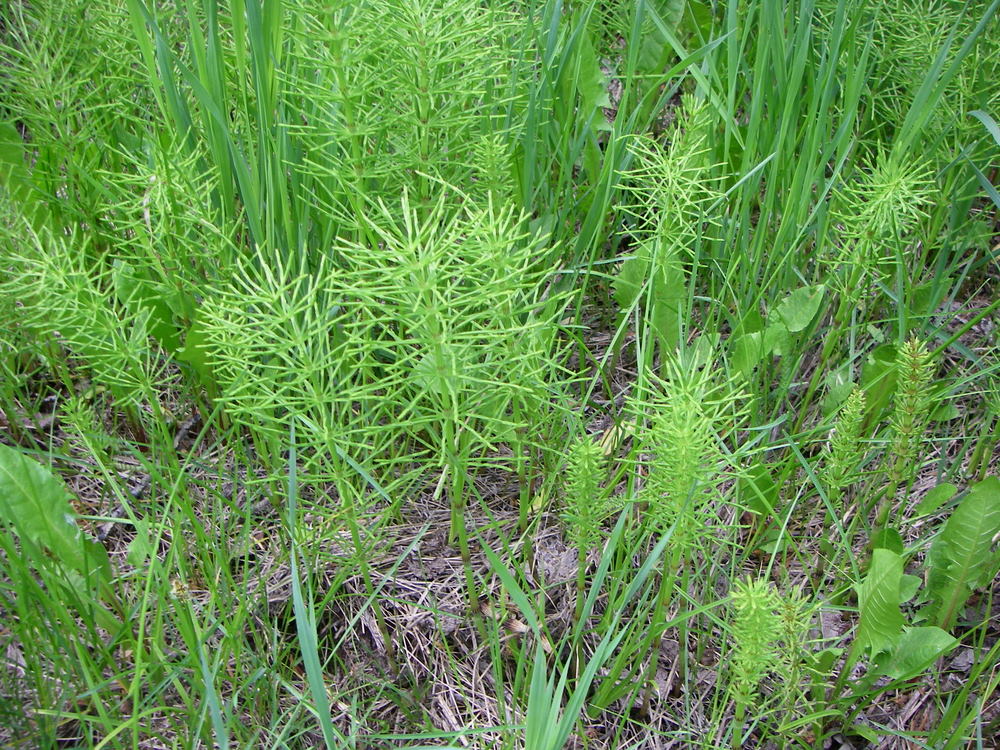Equisetum arvense ( Horsetail)
Horsetail (Equisetum arvense) is an herbal remedy dating back to ancient Roman and Greek medicine. It was used traditionally to stop bleeding, heal ulcers and wounds, and treat tuberculosis and kidney problems. The name Equisetum is derived from the Latin roots equus, meaning "horse," and seta, meaning "bristle."
Horsetail contains silicon, which plays a role in strengthening bone. For that reason, it is sometimes suggested as a treatment for osteoporosis. It is also used as a diuretic, and as an ingredient in some cosmetics. However, very few studies have looked at horsetail's effect in humans.
Plant Description:
Horsetail is descended from huge, tree like plants that thrived 400 million years ago during the Paleozoic era. A close relative of the fern, horsetail is a nonflowering weed found throughout parts of Europe, Asia, the Middle East, and North America. The plant is a perennial (returns each year) with hollow stems and shoots that look like asparagus at first. As the plant dries, silica crystals that form in the stems and branches look like feathery tails and give the plant a scratching effect. That accounts for its historic use in polishing metal, particularly pewter.
Parts Used:
The aboveground parts of horsetail (fresh or dried) are used for medicinal purposes.
Medicinal Uses and Indications:
Few studies have been done of horsetail's effect in humans. Horsetail has traditionally been used as a diuretic (helps rid the body of excess fluid by increasing urine output). One study examined the use of horsetail by people who had a history of uric acid kidney stones. The people who took horsetail did see an increase in diuresis (urine output). Other studies suggest horsetail has antioxidant properties and may inhibit cancer cell growth.
Osteoporosis
Horsetail has been suggested as a treatment for osteoporosis (thinning bone), because it contains silicon, a mineral needed for bone health. However, only one study has examined horsetail for osteoporosis. In that study, 122 Italian women took horsetail dry extract or Osteosil calcium 270 mg twice daily (a horsetail/calcium combination used in Italy for osteoporosis and fractures). Although both groups who took horsetail experienced improved bone density, the study was poorly designed. More research is needed to see whether horsetail has any effect on bone density.
Other
Horsetail is sometimes suggested for the following conditions, although there is no evidence whether it works or not:
Kidney stones
Urinary tract infections
Brittle nails
Minor wounds and burns (applied topically -- you should never apply herbal supplements to open wounds).
Available Forms:
Horsetail is available in the following forms:
Dried herb
Liquid preparations
Horsetail preparations should be stored in well sealed containers to ensure protection from light.
How to Take It:
Pediatric
Because horsetail contains traces of nicotine, it is not recommended for young children.
Adult
Standardized dose: 300 mg, 3 times daily, standardized to contain 10 - 15% silica
Herbal infusion (tea): 2 - 3 teaspoonfuls, 3 times daily. Pour hot water onto herb and steep for 5 - 10 minutes. Drink as directed.
Tincture (1:5): 1 - 4 mL, 3 times daily
External (compresses): 10 g of herb per 1 liter water daily
Be sure to drink enough fluids when taking horsetail preparations by mouth.
Precautions:
The use of herbs is a time honored approach to strengthening the body and treating disease. Herbs, however, contain components that can trigger side effects and interact with other herbs, supplements, or medications. For these reasons, you should take herbs with care, under the supervision of a qualified health care provider trained in the field of botanical medicine.
Horsetail remedies prepared from Equisetum arvense are generally considered safe when used properly. Another species of horsetail, however, called Equisetum palustre is poisonous to horses. To be safe, never take that form of horsetail. Be sure to buy products made by an established company with a good reputation. When possible, select products with guaranteed potency or standardized extracts.
Prolonged use of even the safe form of horsetail (E. arvense) is also not advised.
Taking horsetail by mouth may cause levels of vitamin B1 (thiamin) in the body to drop. If you take horsetail on a regular basis, you should also take a quality multivitamin or at least a B complex supplement daily.
People with heart or kidney disorders, diabetes, or gout should not use horsetail.
Do not drink alcohol regularly while taking horsetail, because horsetail may cause levels of thiamin to drop.
Horsetail may flush potassium out of the body so people who are at risk for low potassium levels should not take Horsetail.
Women who are pregnant or breastfeeding should not take horsetail.


 Cultivations
Cultivations 



